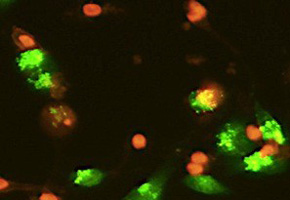

Brazilian scientists studied the interaction of macrophages with a flagellin protein found in pathogenic bacteria and discovered a new pathway for the regulation of the immune response (Unifesp)
Brazilian scientists studied the interaction of macrophages with a flagellin protein found in pathogenic bacteria and discovered a new pathway for the regulation of the immune response.
Brazilian scientists studied the interaction of macrophages with a flagellin protein found in pathogenic bacteria and discovered a new pathway for the regulation of the immune response.

Brazilian scientists studied the interaction of macrophages with a flagellin protein found in pathogenic bacteria and discovered a new pathway for the regulation of the immune response (Unifesp)
By Karina Toledo
Agência FAPESP – By studying the in vitro interaction between macrophages and bacteria of the genus Salmonella, researchers at Universidade Federal de São Paulo (Unifesp) discovered a previously unknown mechanism by which the immunological system controls infections.
The results of the study were published this August in the Proceedings of the National Academy of Sciences (PNAS). Conducted with FAPESP funding under the Young Investigators in Emerging Centers program, the study was coordinated by Karina Ramalho Bortoluci, an adjunct professor in the Department of Biological Sciences, and includes the doctoral research of Silvia Lucena Lage.
“Macrophages are immunological sentinels. They are first-line defense cells that recognize antigens and determine whether these are a threat to the organism. When macrophages come into contact with molecules found in pathogenic bacteria, a series of responses is activated in these cells to help to control infection,” said Bortoluci.
The group at Unifesp’s Institute of Environmental, Chemical and Pharmaceutical Sciences (ICAQF) specifically studied what happens when macrophages encounter a protein called flagellin, found in the flagellum (a locomotory organ) of mobile pathogenic bacteria, such as Salmonella and Legionella.
According to Bortoluci, previous studies have shown that flagellin connects to two different receptors found in macrophages: toll-like receptor 5 (TLR5), which is located in the cell membrane, and Nod-like receptor family CARD domain-containing protein 4 (NLRC4).
“In the presence of flagellin, NLRC4 forms a molecular complex known as an inflammasome. This has two main consequences: the release of the inflammatory cytokines interleukin-1β (IL-1β) and interleukin-18 (IL-18) and the induction of a type of inflammatory cell death known as pyroptosis,” she said.
Unlike apoptosis, which is a silent physiological cell death, pyroptosis warns the immunological system that something is wrong. “The macrophage explodes, and everything inside it is thrown outside. Some of these molecules connect to other receptors of the immune system, and this causes certain types of defense cells, and mainly neutrophils, to migrate to the site in an attempt to control the infection,” said Bortoluci.
For the inflammasome pathway to be activated and for pyroptosis to occur, a protein known as caspase-1 must be present. In conducting experiments with mice genetically modified not to express caspase-1, the researchers observed that another type of inflammatory death occurred in macrophages in the presence of flagellin.
“We observed that there was a type of death that mixed the characteristics of apoptosis and pyroptosis and, as a consequence, caused a reduction in the number of bacteria. This led us to investigate the existence of a new infection control mechanism initiated by the recognition of flagellin,” explained Bortoluci.
By studying the morphology of macrophages in the presence of flagellin, the researchers verified that the lysosomes (organelles responsible for digesting particles from external sources and for renovating cellular structures) seemed to break moments before cellular death.
To confirm the involvement of the lysosomes in the process, the researchers used substances capable of inhibiting the action of cathepsins (proteases that are abundant in these organelles) and verified that both the response induced by the inflammasome and the response induced by the lysosomes were interrupted in the absence of these proteins.
“We not only discovered the existence of this new inflammatory death process, which is dependent on the action of lysosomes, but also verified that the proteases in the lysosomes – mainly cathepsin B – regulate the whole function of the inflammasome pathway. Therefore, activation of the lysosome by flagellin is a central event in the immune response inside a macrophage. Even when the classical inflammasome pathway is preserved, macrophages need this liposomal pathway to activate their inflammatory death,” said Bortoluci.
Application
According to Bortoluci, in addition to providing knowledge about the immunological system, the discovery could be useful for the development of new adjuvants, i.e., substances that are added to vaccines in order to potentiate the immune response against a pathogen.
“The majority of existing vaccines are not very immunogenic because they use dead or weakened microorganisms. For this reason, adding auxiliary agents is common. They cause an inflammatory reaction in the organism, and this makes the response more efficient,” explained the Unifesp professor.
The only auxiliary agent that is currently approved for human use is aluminum hydroxide. According to Bortoluci, several in vitro and animal studies conducted on flagellin have revealed that it is a powerful auxiliary agent.
“We still haven’t broached this question, but it is possible that part of flagellin’s auxiliary effect is due to its action on lysosomes, which makes them potential therapeutic targets,” said Bortoluci.
Republish
The Agency FAPESP licenses news via Creative Commons (CC-BY-NC-ND) so that they can be republished free of charge and in a simple way by other digital or printed vehicles. Agência FAPESP must be credited as the source of the content being republished and the name of the reporter (if any) must be attributed. Using the HMTL button below allows compliance with these rules, detailed in Digital Republishing Policy FAPESP.




